|
Twin
Disc Clutch Company During World War Two
Racine, WI
1918-Current
This page updated 11-21-2024.
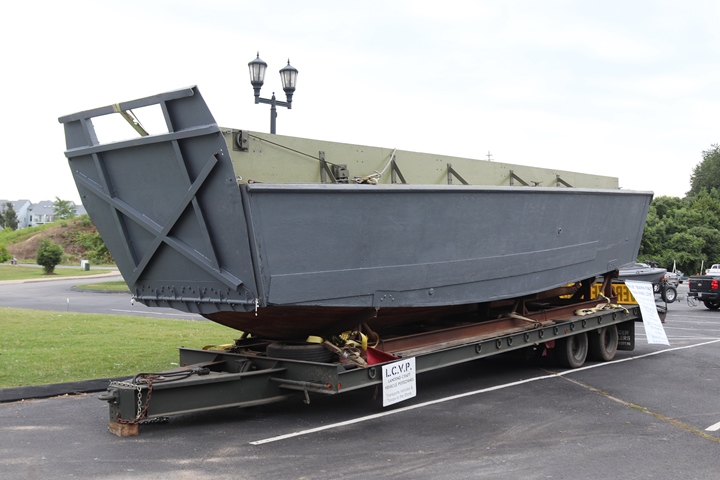
The Landing Craft, Vehicle, Personnel (LCVP) was noted by General
Eisenhower as the boat that won World War Two for the United States.
While that statement can be debated as to how true it actually is, what
is true is that the LCVP was a very important landing boat for the
United States in the war and was the first of several types of landing
craft to land during a seaborne invasion. The LCVP is also known
as the Higgins Boat, named after Andrew Jackson Higgins, who is considered the
inventor of this type of landing craft with a droppable ramp on the bow.
The LCVP was built by Higgins Industries, Chris-Craft, Dodge Boat and
Plane, Matthews Company, Owens Yacht Company, and Richardson Boat.
The six companies built a total of 23,358 LCVPs during World War Two.
Author's photo.
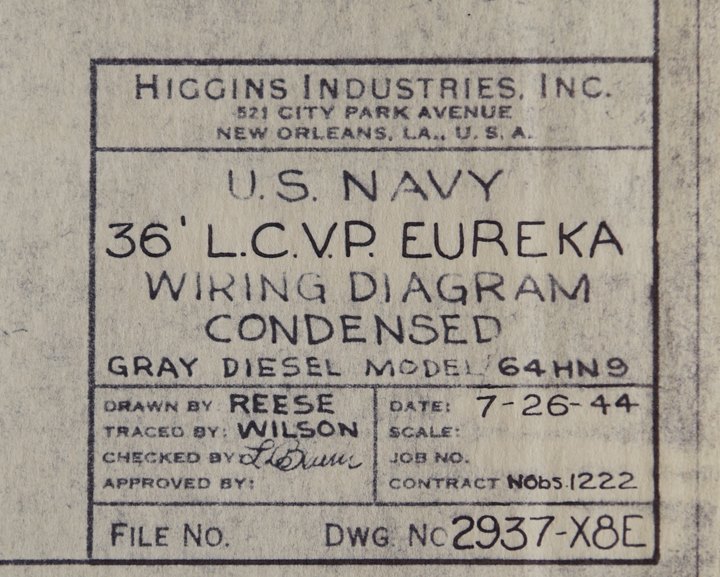
The Gray Marine Motor Company Model 64HN9
diesel engine as shown here, on this Higgins Industries engineering
drawing, was one of several engines that powered the LCVP. The LCVP
and the Gray Model 64HN9 are widely recognized among World War Two
historians and enthusiasts. However, for the Gray 64HN9 engine to
propel the LCVP through the water, it needed a transmission with a
clutch and a
forward and reverse gear. World War Two historians have overlooked
this very important component of the drive train that was manufactured
by the Twin Disc Company of Racine, WI.
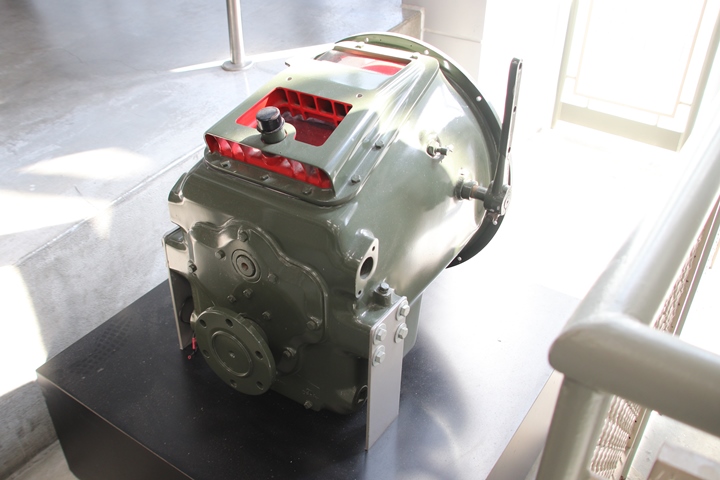
This is an example of a Twin Disc
transmission that was used in many types of landing craft besides the LCVP. This is the device that transferred the power of the engine
to the landing craft's propeller. It is the unknown but very
important part of the drive train for several types of landing craft
that landed on enemy beaches during World War Two. This example is
on display at the National World War II Museum in New Orleans, LA.
Of the many military museums that I visited during my research trips, this is
the only Twin Disc transmission I have found on display. Author's
photo.
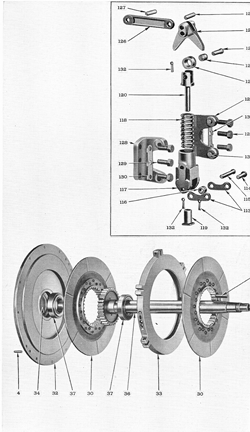 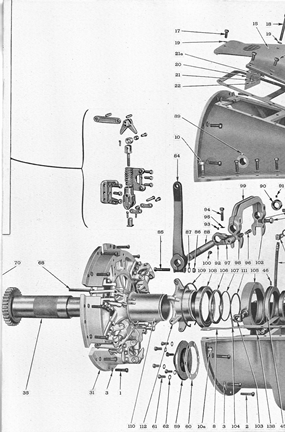 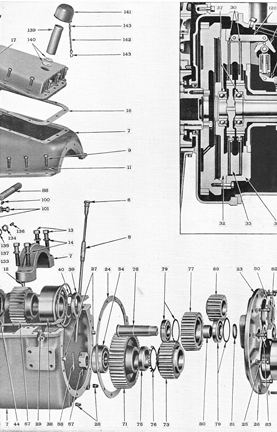 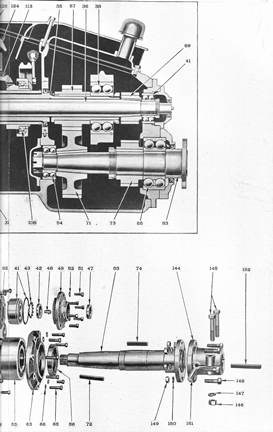
The two castings that make up the case of
the transmission hide the 156 components that make the unit operate. It
is a very complicated piece of mechanical equipment.
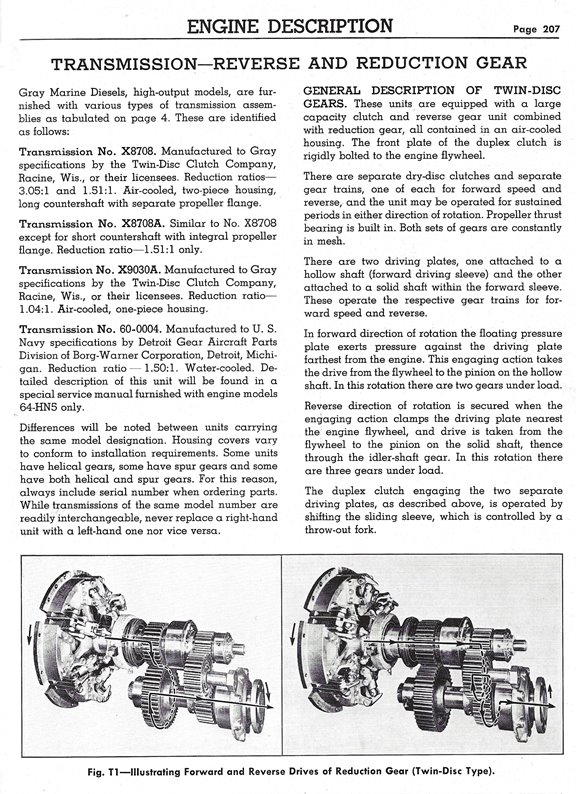
This page from a Gray Marine Motor Company World War Two training manual
shows that all of the different engines the company made, except
for one, were equipped with
three different types of Twin Disc Company transmissions.
The Borg-Warner transmission was only used with the 64-HN5 engine.
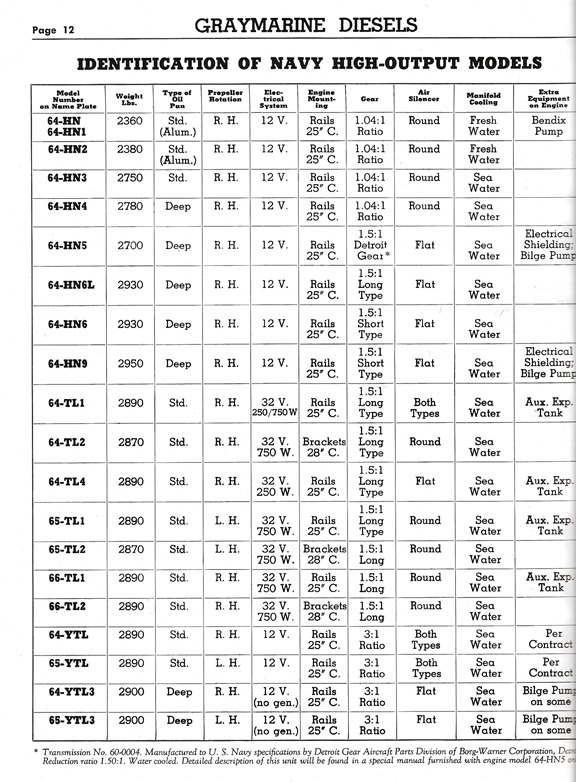
This page from a Gray Marine Motor Company
World War Two training manual shows that all of the different engines the
company made were equipped with Twin Disc Company transmissions.
The one exception is the 64-HN5 engine.
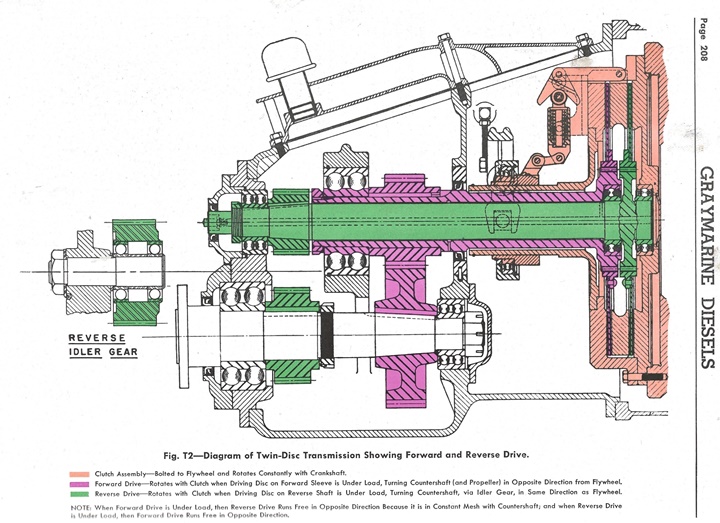
This color image gives another internal view
of the Twin Disc transmission used on most small landing craft of World
War Two.
The LCVP was not the only type of
36-foot landing craft during World War Two, although it was the most
prominent as shown in Table 1. Table 1 also shows that there were
other types of engines used to power the landing craft when Gray-built
engines were not available. But all of the engines and landing
craft shown in Table 1 required Twin Disc transmissions.
|
Table 1 - Twin
Disc and Gray Marine
Motor Company
Engine World War Two Landing Craft Applications
|
| Type
Landing Craft |
Number
built |
Type
Engine |
Engines per Landing Craft |
Total Twin Disc Transmissions and Gray Marine Engines per
Landing Craft |
| LCP(L) |
2,193 |
Gray Marine 64HN9/Detroit Diesel 6-71,
Hall-Scott Invader, and Superior Diesel |
1 |
2,193 |
| LCP(R) |
2,572 |
Various including
Gray Marine 64HN9/Detroit Diesel 6-71 |
1 |
2,572 |
| LCV |
2,366 |
Various including
Gray Marine 64HN9/Detroit Diesel 6-71 |
1 |
2,366 |
| LCVP |
23,353 |
Gray Marine
64HN9/Detroit Diesel 6-71 or Hudson built Hall-Scott 210 hp
gasoline powered Invader |
1 |
23,353 |
| LCM(3) |
8,631 |
Gray Marine
64HN9/Detroit Diesel 6-71 or
Kermanth 100 hp six cylinder gasoline engines |
2 |
17,262 |
| LCM(4) |
2,718 |
Gray Marine
64HN9/Detroit Diesel 6-71 or
Kermanth 100 hp six cylinder gasoline engines |
2 |
5,436 |
| LCM(6) |
2513 |
Gray Marine
64HN9/Detroit Diesel 6-71 or
Kermanth 100 hp six cylinder gasoline engines |
2 |
5,026 |
| LCT(5) |
470 |
Gray Marine 64HN9/Detroit Diesel 6-71 |
2 |
940 |
| LCT(6) |
960 |
Gray Marine
64HN9/Detroit Diesel 6-71 |
2 |
1,920 |
| Totals |
45,776 |
|
|
61,068 |
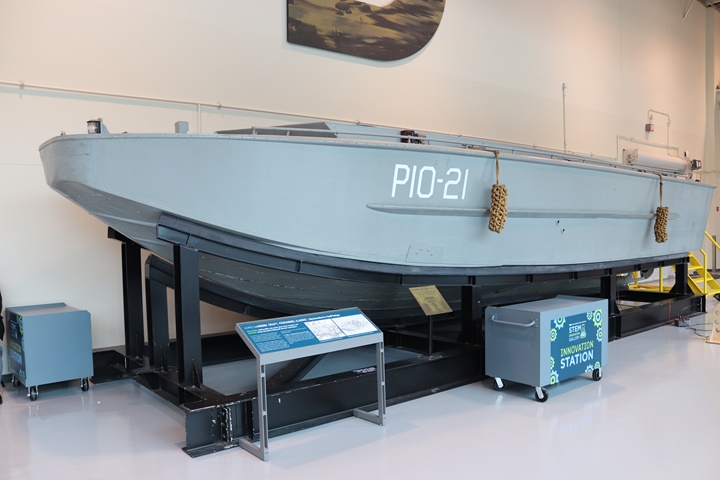
This 1944 Landing Craft, Personnel, Large (LCP(L))
was the first type of landing craft that Andrew Higgins designed.
It was this type of boat that Higgins Industries first built with a Twin
Disc transmission.
This particular boat was built by Higgins
Industries in New Orleans in October 1944 and is currently on display at the National WWII Museum in New Orleans.
It has been returned home for museum visitors to see. It is the
only one on display left in the world. Hall-Scott Invader engines
were one of three types of engines Higgins Industries specified for this
landing craft. They were the Gray/Detroit Diesel, Superior
Diesel, and Hall-Scott Invader engines. Each required a Twin
Disc transmission. Author's photo.
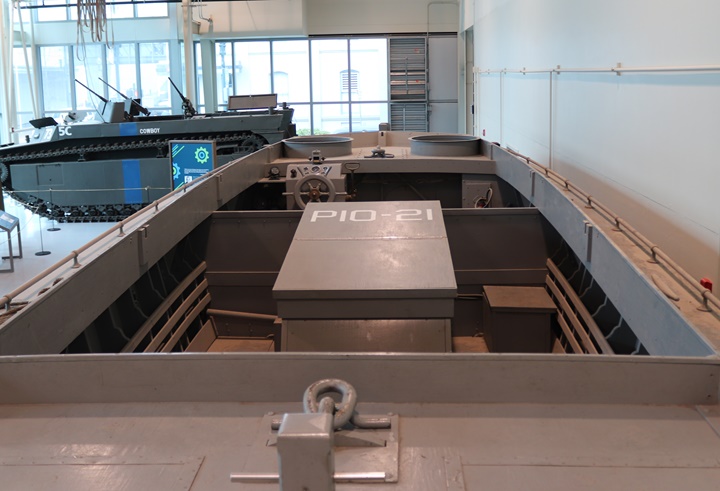
Note the location of the coxswain's steering
station, the two gun tubs for mounting self-defense machine guns, and the
engine housing in the middle of the boat.
Note also that the 25 armed troops carried in the craft were in two
different sections of the LCP(L). Author's Photo.
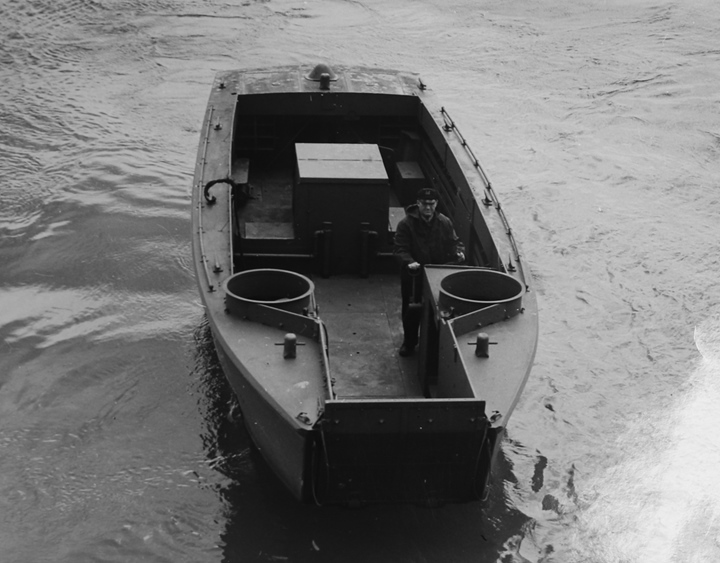
The LCP(R) was an LCP(L) with the bow
modified for a three foot wide ramp. The U.S. Navy had Chris-Craft
modify one of the LCP(L)s it was building and install a three-foot wide
landing ramp. This was the U.S. Navy's attempt to build a landing
craft with a ramp. The engines in this type of boat had Twin Disc
transmissions. Photo courtesy of the
Algonac-Clay Township Historical Society.
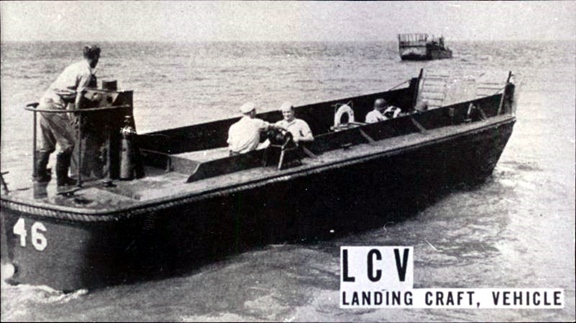
The LCV was Andrew Higgins' first attempt to build a landing craft
with a ten-foot wide landing ramp. There were 2,633 LCVs built between 1941
and 1943 by Higgins Industries, Chris-Craft, Richardson, and Owens Yacht.
While not built in the
quantities of the LCVP, LCVs saw duty during early American invasions in
World War Two. It continued to be utilized even after the LCVP
became the dominant landing craft later in the war. There are several key differences
between the original LCV and the later LCVP that can be seen in the
photo above.
The most obvious is the coxswain's station, which is on the transom of
the LCV. It was moved into the boat on the LCVP. Note
the ramp winch is also located in an exposed position on the port
side of the LCV. In the LVCP, it was moved down into the boat
to protect the crewman operating it from hostile fire. The LCV
engine required a Twin Disc transmission.
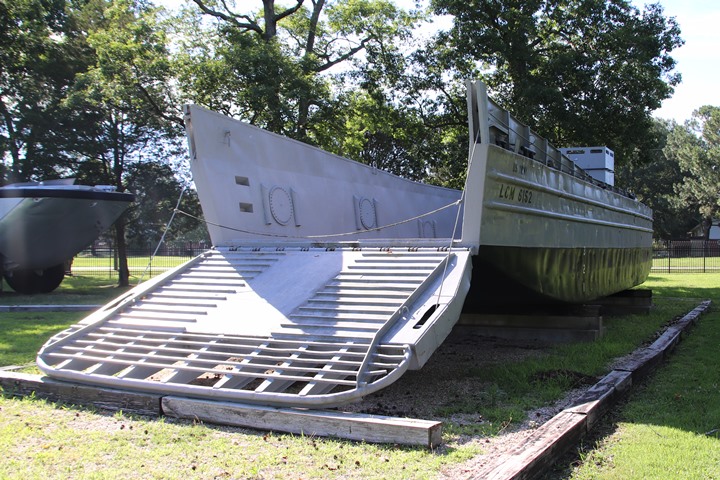
This is one of 960 LCM-6s that were produced
during World War Two and powered by two Gray Marine
64HN9/Detroit Diesel 6-71 engines equipped with Twin Disc
transmissions. Author's photo taken at the U.S. Army
Transportation Museum at Fort Eustis.
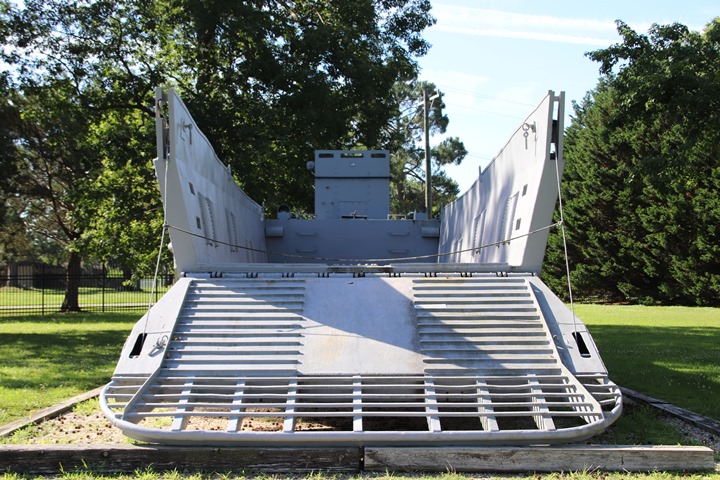
Author's photo taken at the U.S. Army
Transportation Museum at Fort Eustis.
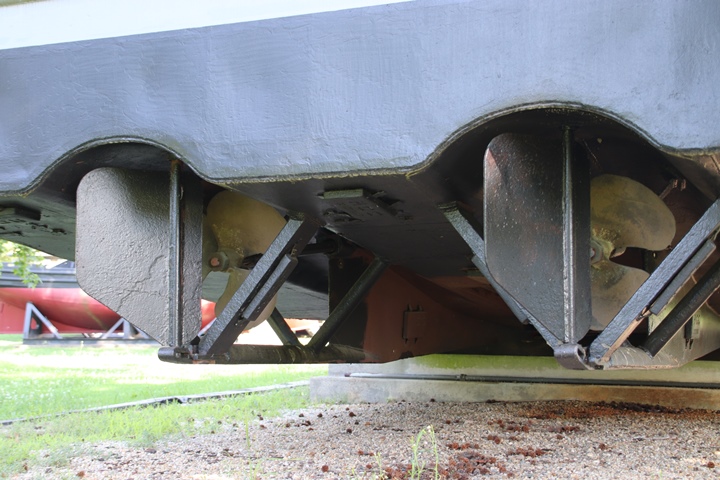
Author's photo taken at the U.S. Army
Transportation Museum at Fort Eustis.
Twin Disk Company History: The
Twin Disc Company was formed in 1918 for the manufacture of farm tractor
clutches. Co-founders were Percy H. Batten, Arthur B. Modine, and
Thomas Fawick, inventor of the Twin Disc Clutch. Early investors
included local business leaders Henry Wallis Jr. of the Wallis Tractor
Co. and H.F. Johnson of S.C. Johnson & Son. From the further development
of farm tractor clutches
by company founder, P.H. Batten, Twin Disc developed durable marine
transmissions for Great Lakes fishing boats in the 1930ís, manufacturing
countershaft reduction gears with 100 percent reverse power.
World War Two was a significant turning point
for the company. With it being the main supplier of the
transmissions that were used in nine types of landing craft
used around the world, Twin Disc became a recognized name in the marine
propulsion industry.
How cool is this?
John H. Batten, the current President and Chief Executive Officer of the
Twin Disc Company, is the great grandson of P.H. Batten, who founded the
company. This is extremely rare and may be the only case where a
fourth generation member of the family is still involved, let alone the
President and CEO of a company. Normally, by the third generation,
the grandchildren have no interest in the family business, or are not properly
able to manage it, resulting in the companies going out of
business.
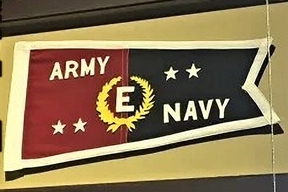
The Twin Disc Company won the Army-Navy "E"
Award five times during World War Two.
The "E" flag shown here shows the four stars on the flag. Twin
Disc Company had this flag on display at its former Heritage Center.
The company won its first award in September 1943.
Twin Disc Company World War Two Products:
As noted above, the company produced over 61,000 marine
transmissions for various small landing craft. Table 1 shows that the Racine plant had $306,000 in major contracts with both
the Army Corps of Engineers and the U.S. Navy. Table 2 shows that
its Rockford, IL plant had $123,000 for torque converter parts for the
Navy. From the large number of landing craft transmissions built, companies such as Gray Marine Motor Company ordered
the required transmissions directly from Twin Disc.
Table 1 - Twin Disc Clutch Company's
Major World War Two Contracts - Racine, WI Plant
The information below
comes from the "Alphabetical Listing of Major War Supply
Contracts, June 1940 through September 1945." This was
published by the Civilian Production Administration,
Industrial Statistics Division. |
|
Product |
Contract Amount |
Contract Awarded
|
Completion
Date |
| Clutch Parts -
Army Corps of Engineers |
$60,000 |
2-1943 |
5-1943 |
| Machine Parts -
Army Corps of Engineers |
$70,000 |
7-1943 |
9-1943 |
| Twin Disc Clutch
Parts - Army Corps of Engineers |
$57,000 |
12-1943 |
8-1944 |
| Marine Engine
Gears - Navy |
$119,000 |
2-1945 |
11-1945 |
| Total |
$306,000 |
|
|
Table 2 - Twin Disc Clutch Company's
Major World War Two Contracts - Rockford, IL Plant
The information below
comes from the "Alphabetical Listing of Major War Supply
Contracts, June 1940 through September 1945." This was
published by the Civilian Production Administration,
Industrial Statistics Division. |
|
Product |
Contract Amount |
Contract Awarded
|
Completion
Date |
| Torque Converter
Parts - Navy |
$123,000 |
6-1944 |
12-1944 |
| Total |
$123,000 |
|
|
More Photos of the Twin Disc Transmission
at the National World War II Museum in New Orleans, LA:
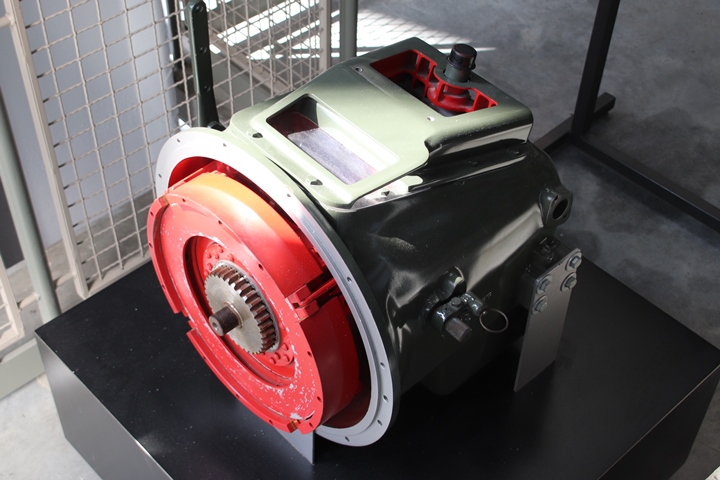
Author's Photo.
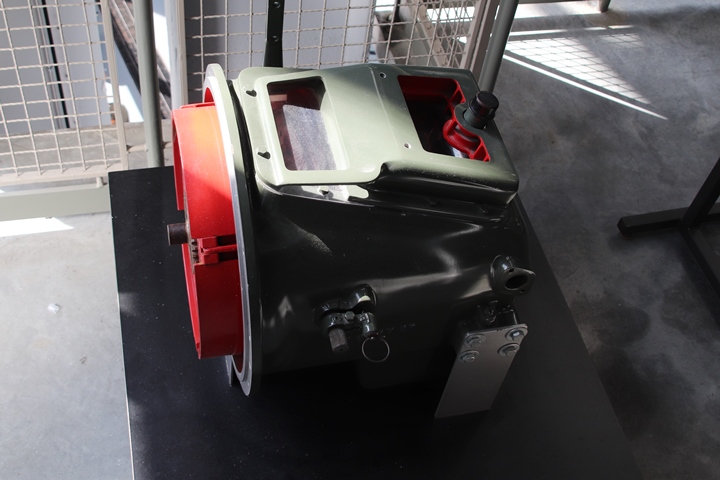
Author's Photo.
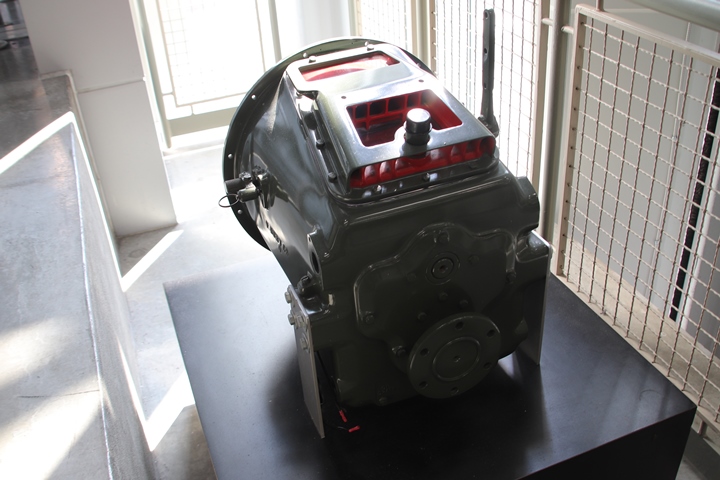
Author's Photo.
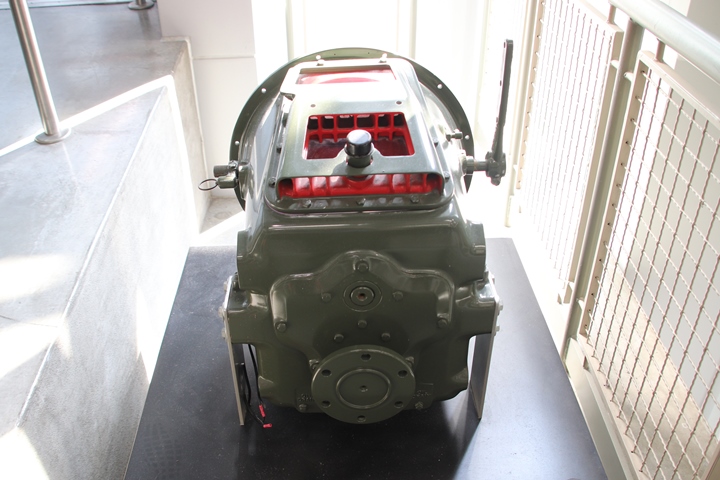
Author's Photo.

Author's Photo.
Exploded View and Parts Listing for the
Twin Disc Model X8708A Transmission:
   
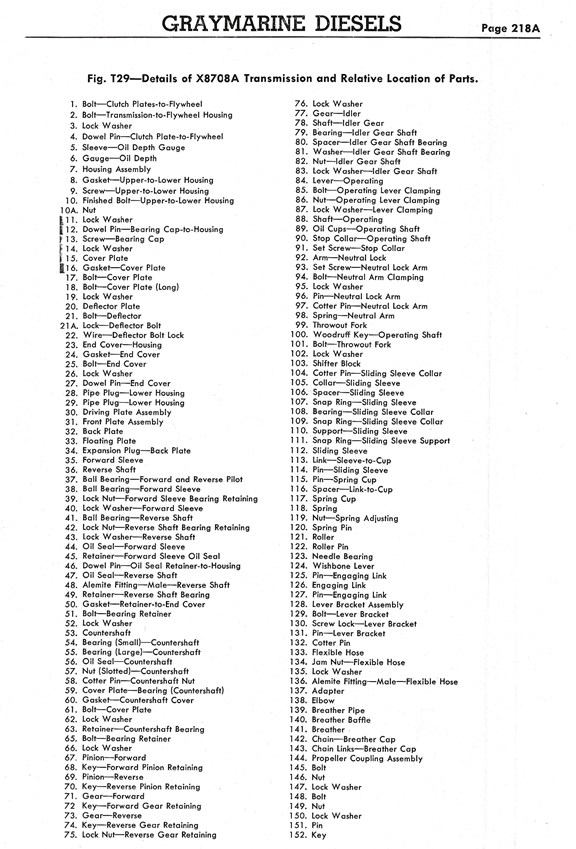
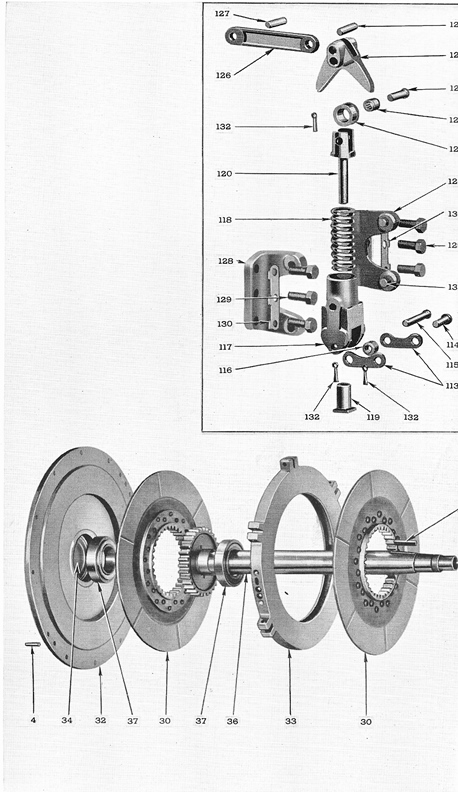
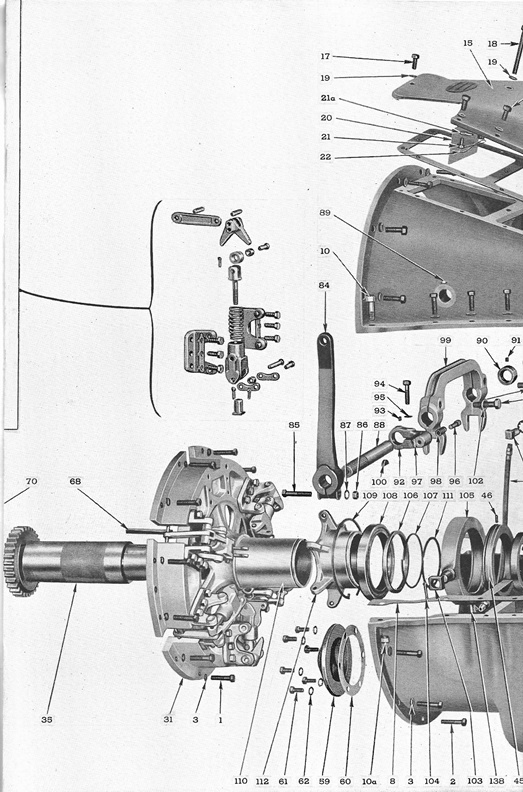
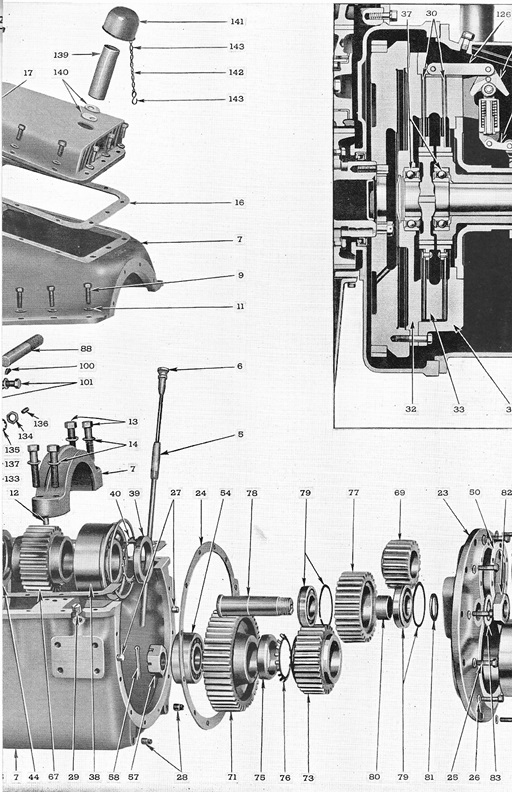
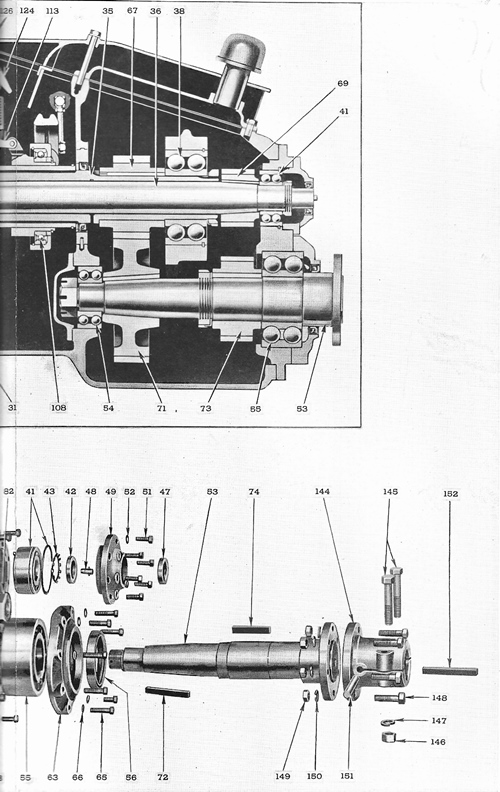
Muncie Gear Works-Built Model X8708A
Transmission: As noted on page 207 of the Engine Description
above,
authorized licensees also built the
transmission. Apparently, the Twin Disc Clutch Company was not
able to keep up with production during World War Two, and other
companies became involved. One of the authorized licensees was the
Muncie Gear Works in Muncie, IN.
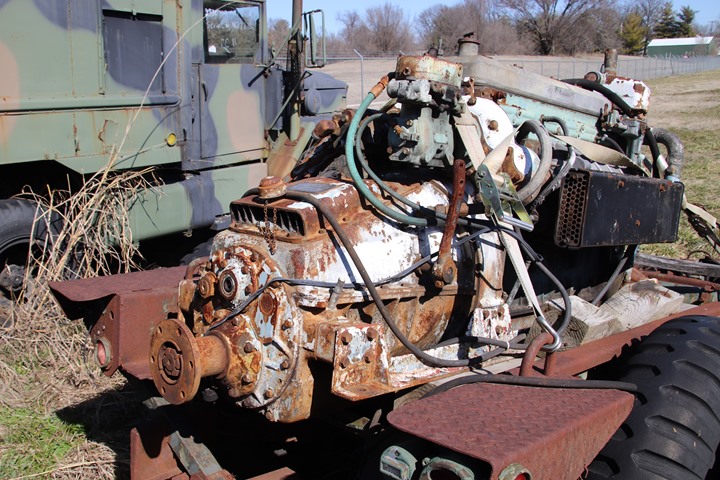
This Gray Marine Motor Company engine with a
transmission is part of the collection at the Indiana Military Museum in
Vincennes, IN. Author's Photo.
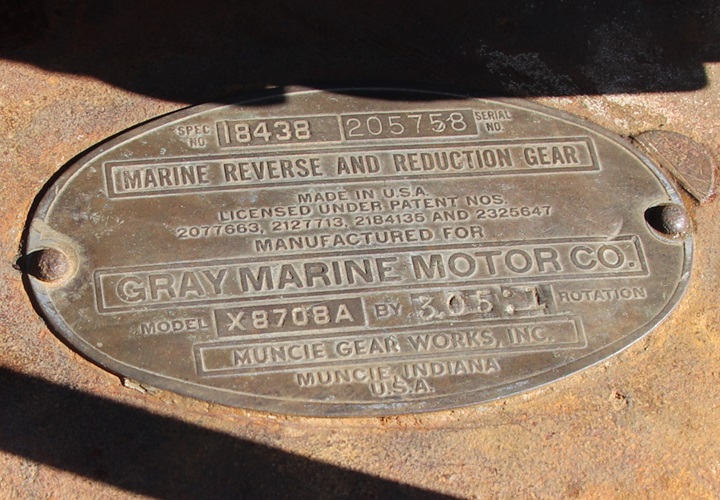
Of the several landing boat transmissions I
have found, this is the only one that has a legible data plate on it.
In this particular case, it was built by the Muncie Gear Works and not
Twin Disc.
Other Twin Disc World War Two Products and
Applications:
Le Roi Company Compressor Trucks:
Twin Disc supplied over 10,000
clutches for Le Roi G-105 air compressors mounted on GMC CCKW 2-1/2 -ton
6x6 and GMC AFK-352 1-1/2-ton 4x4 trucks during World War Two.
Table 3 shows that the Le Roi Company built at least 9,606 compressors
for mounting on the GMC CCKW truck. Le Roi also supplied 819
compressors for the GMC AFK-352. There were also several U.S. Navy
contracts for the Le Roi G-105 compressor with the Twin Disc clutch.
The Twin Disk part number was SL-2-11-1/2.
Table 3 - Le Roi Company's Army Corps of Engineers Engine
and Compressor Serial Numbers with Twin Disc Clutches
The contract numbers and the associated engine and
compressor serial numbers were obtained from TM 5-5060, Le
Roi Air Compressor 105GA Technical Manual dated November 30,
1942. However, interior pages show a Le Roi copyright
of 1944. Note that the engine serial numbers are even
numbers and the compressor serial numbers are the
corresponding odd numbers.
Not all of the contracts for
air compressors are comprehended in this table. There
are two Army Corps of Engineering contracts that were not
listed in TM 5-5060, Le Roi Motorized Air Compressor, Model
105GA : Technical Manual : Includes Independent Pneumatic
"Thor" Air Tools, 1942.
|
|
Contract Number |
Engine Serial Numbers |
Compressor Serial Numbers
|
Quantity |
Contract Amount |
Unit Cost |
|
978-ENG-3969 |
157000-158998, inclusive |
157001-158999, inclusive |
1,000 |
$2,543,000 |
$2,450 |
|
160200-160274, inclusive |
160201-160275, inclusive |
38 |
|
978-ENG-5371 |
171500-172508, inclusive |
171501-172509, inclusive |
505 |
$1,324,000 |
$2,622 |
|
1122-ENG-969 |
172510-177250, inclusive |
172511-177251, inclusive |
2,370 |
$7,553,000 |
$3,187 |
|
1122-ENG-972 |
177262-177488, inclusive |
177263-177489, inclusive |
114 |
$422,000 |
$3,702 |
|
1088-ENG-2067 |
177490-178888, inclusive |
177491-178889, inclusive |
700 |
$2,063,000 |
$2,947 |
|
1088-ENG-2332 |
183900-184010, inclusive |
183901-184011, inclusive |
56 |
$139,000 |
$2,482 |
|
1088-ENG-2751 |
189000-190212, inclusive |
189001-190213, inclusive |
607 |
$2,131,000 |
$3,510 |
|
1088-ENG-2929 |
190214-192030, inclusive |
190215-192031, inclusive |
909 |
$3,605,000 |
$3,606 |
|
32-ENG-28 |
194000-195556, inclusive |
194001-195557, inclusive |
779 |
$3,002,000 |
$3,854 |
|
47013-ENG-460 |
201004-204620, inclusive |
201005-204621, inclusive |
1,809 |
$6,934,000 |
$3,803 |
|
11114-ENG-134 |
200560-202002, inclusive |
200561-202003, inclusive |
722 |
? |
? |
| |
|
Total |
9,609 |
|
|
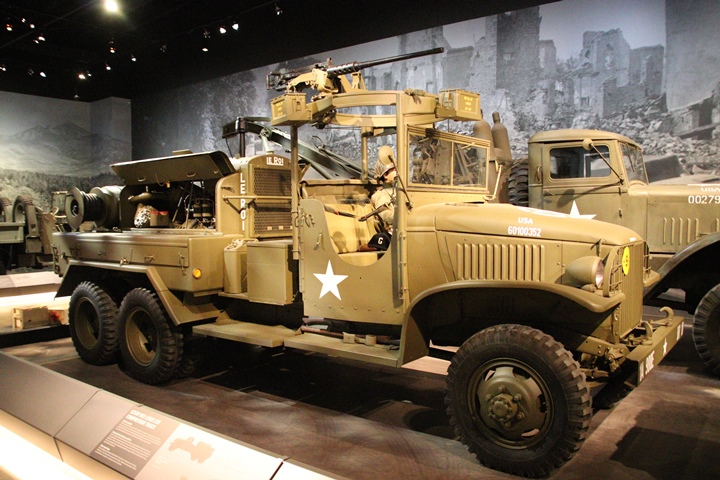
This Le Roi compressor truck is on display
at the National Museum of Military Vehicles in Dubois, WY.
Author's photo added 11-21-2024.

Author's photo added 11-21-2024.
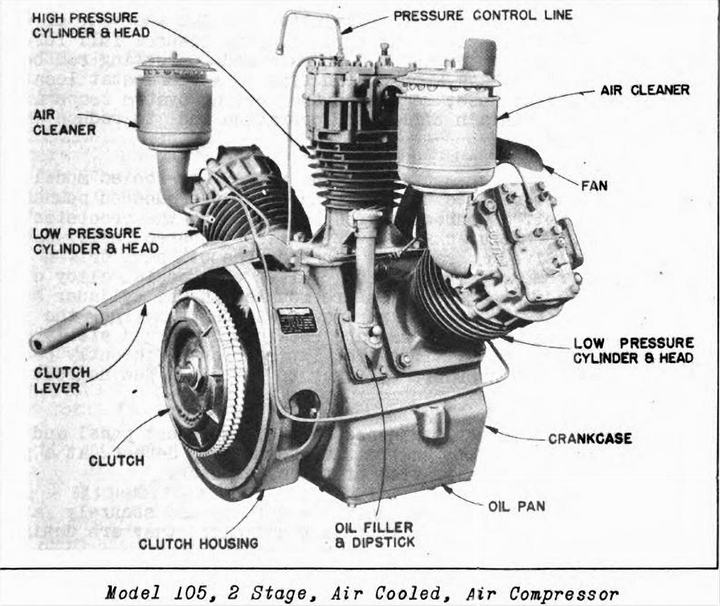
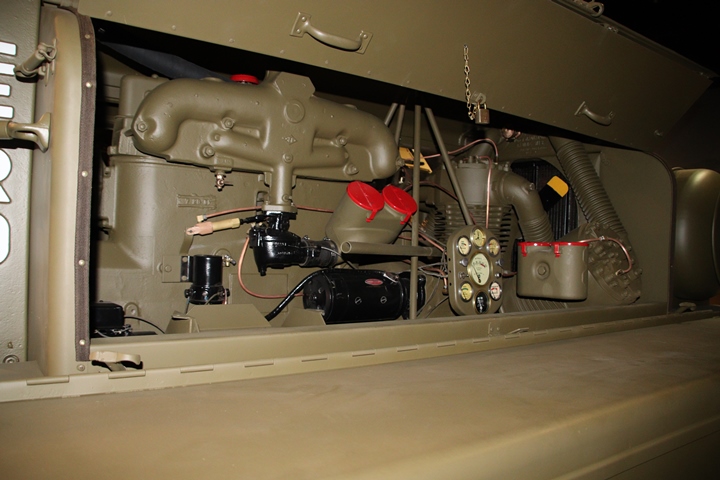
This image shows the Twin Disc clutch handle
above the Delco-Remy DC generator. Author's photo added 11-21-2024.
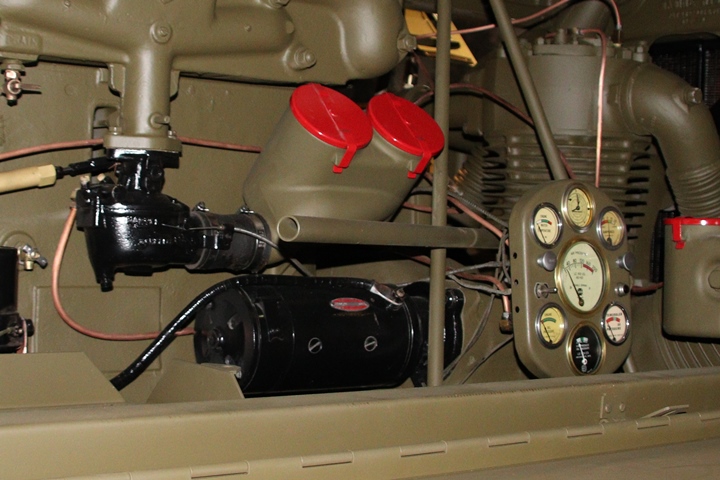
Author's photo added 11-21-2024.
Michigan Power Shovel Company TM-16 Crane:
Twin Disc Company Model X7876 clutch is for the crane. An
estimated 756 TM-16s were built by both the Michigan Power Shovel Company
and International Detrola during World War Two.
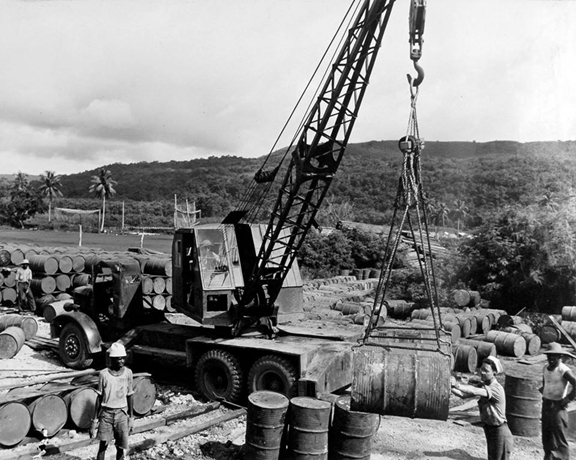
This U.S. Navy
Michigan Power Shovel truck crane is being used by navy stevedores. Palm
trees in the background suggest this is in the South Pacific. Image
courtesy of Andre Margage via Jeff Lakaszcyck.
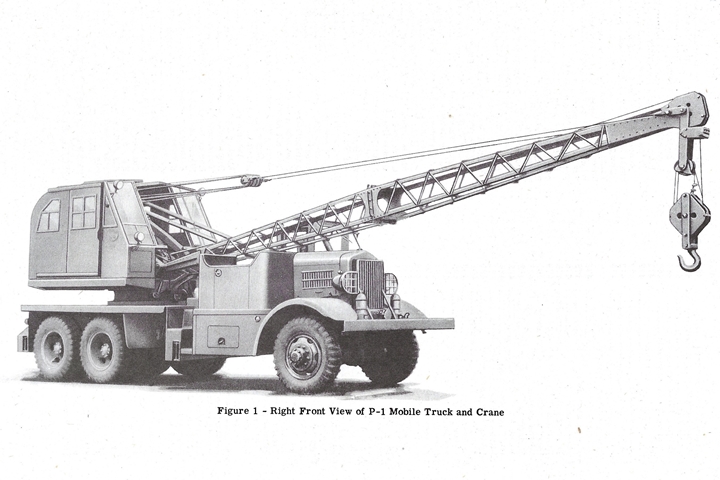
An estimated 455 Biederman Motors
Corporation P-1 crane trucks with Twin Disc Company Model X7876 clutches
were built during World War Two.
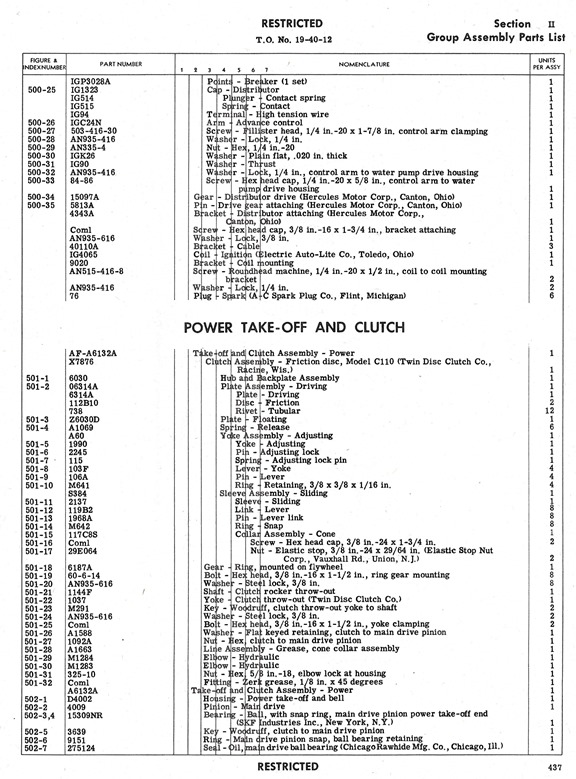
This image and the one below show the parts
listing and exploded view of the Model X7876 clutch used in the crane.
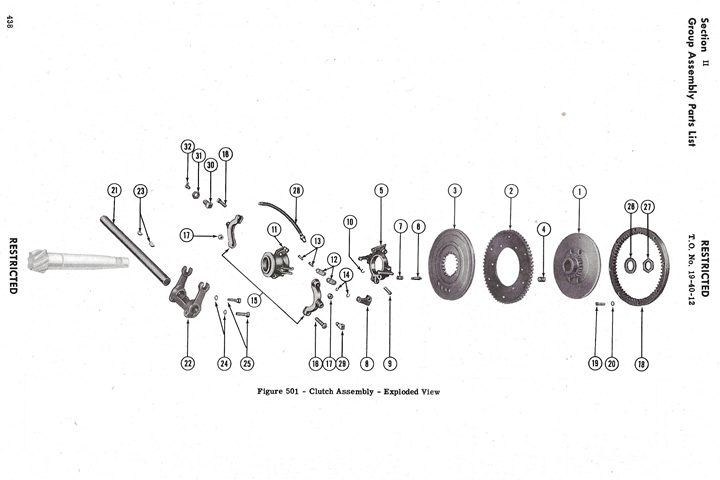
Allis-Chalmers M4 and M6 High Speed Tractor
Torque Converters: The devices were produced by the company's
Rockford, IL factory.
M4 High Speed Tractor: Allis-Chalmers
built a total of 5,811 M4 high speed tractors in three different versions.
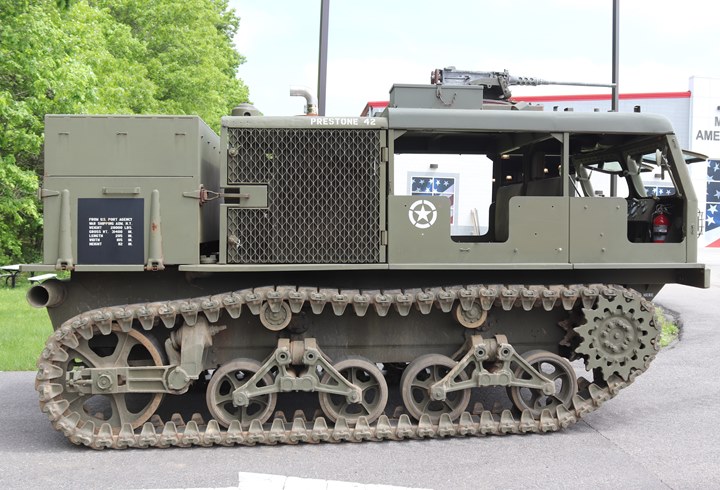
This totally restored and operational M4 is
owned by the Museum of American Armor in New Bethpage, NY.
Author's photo.
WW2 Armor Allis-Chambers M4 High Speed
Tractor Restoration: The next set of photos starts with photos
I took of the WW2 Armor M4 High Speed Tractor while undergoing
restoration in March 2019 at the organization's facility in Osteen, FL.
Next is a photo of the restored M4 at the 2019 Conneaut D-Day event in
August 2019 in Conneaut, OH.
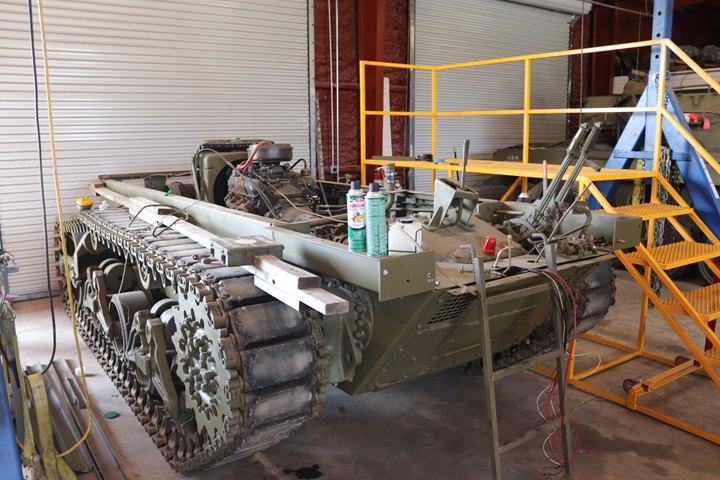
Author's photo.
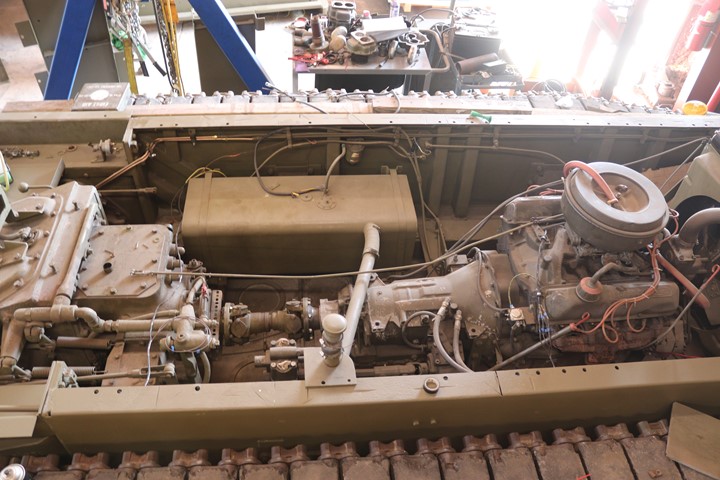
A Ford V-8 has replaced the original
Waukesha inline six-cylinder engine. Author's photo.
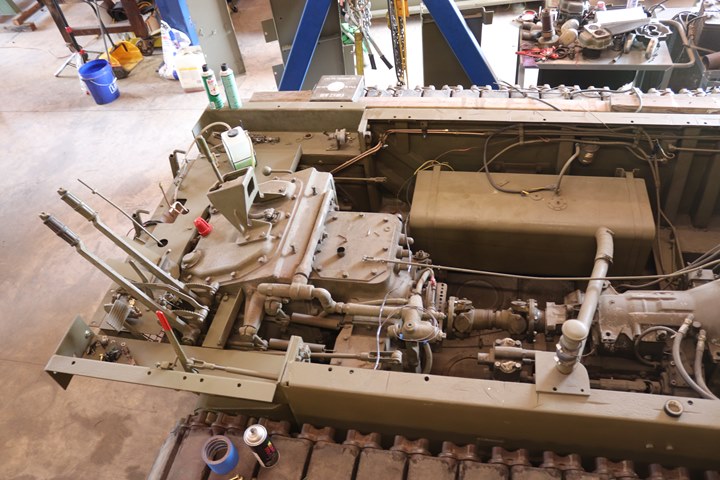
With the body of the tractor off, one can
see the layout of the chassis and the drive train. The fuel tank
is at the top of the photo. Author's photo.
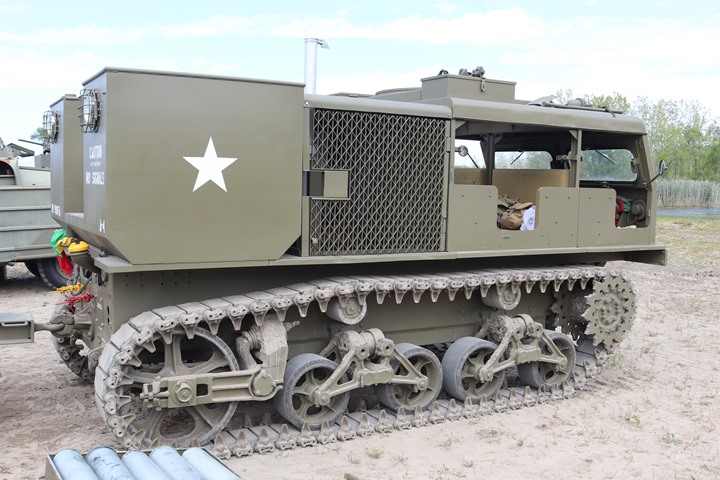
Author's photo.
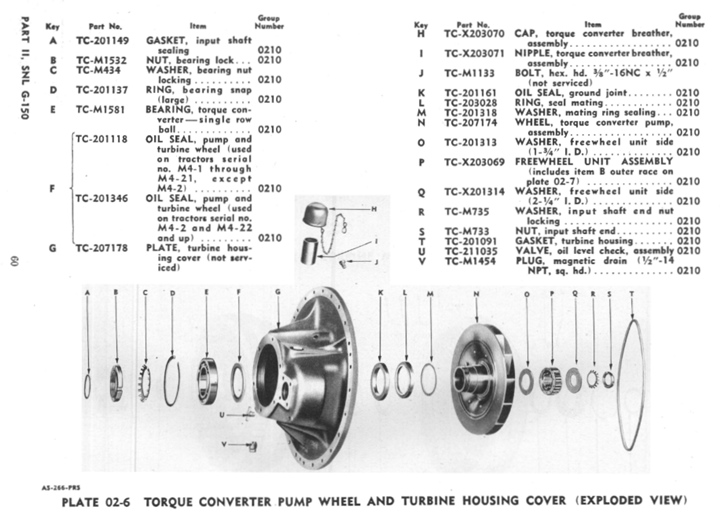
This and the following three images are from
the M4's parts manual and show the exploded views and part numbers for
the torque converter. TC is the designation for the Twin Disc
parts.
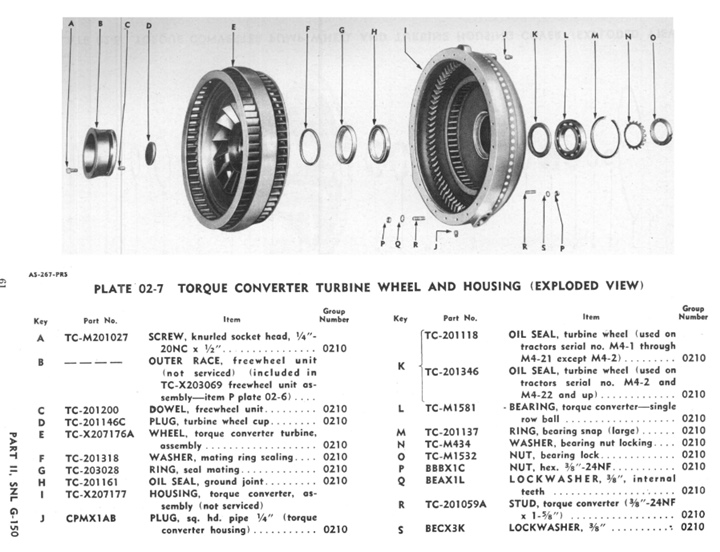
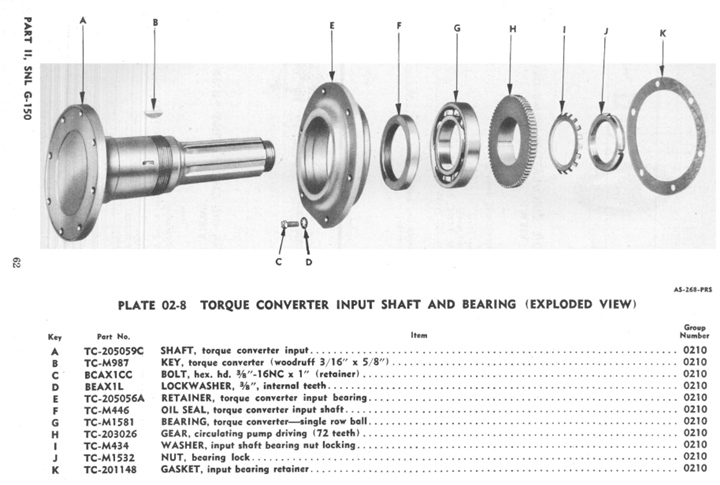
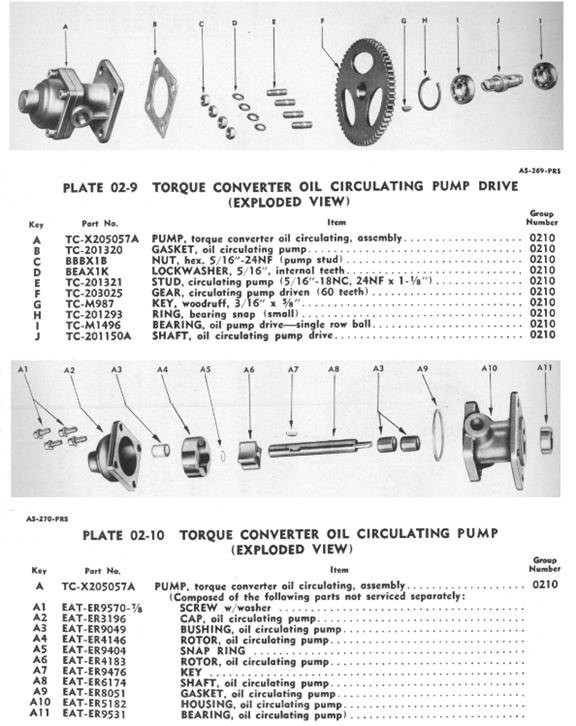
M6 High Speed Tractor: 1,235 of
these 38-ton tractors were built in 1944-45 at the Allis-Chalmers La
Porte, IN Works. There are only two known to still exist; one in The
Netherlands, and one at the Indiana Military Museum in Vincennes,
IN, 250 miles from where it was originally built. It is in need of
extensive restoration, as can be seen below. It is the one that is
shown below.
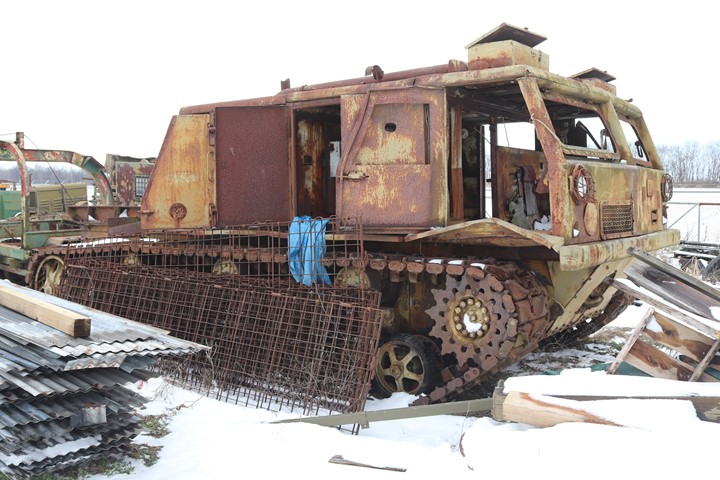
The Indiana-built M6 is located outside with
a lot of other equipment the museum has purchased. Hopefully, it
is waiting for restoration when time and funding becomes available.
Author's photo.
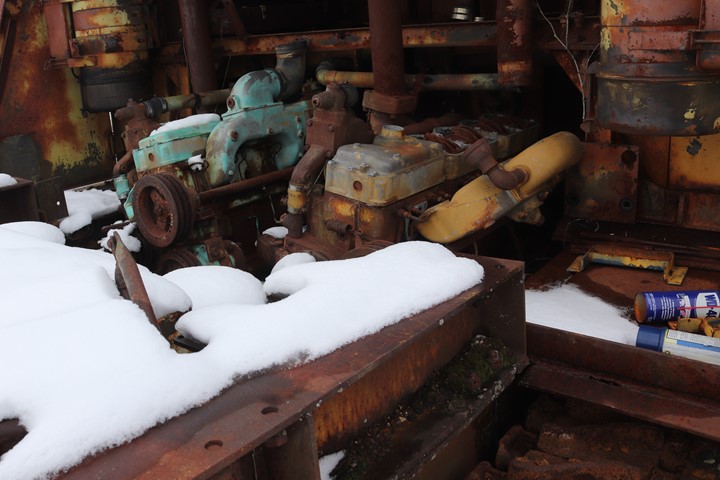
The M6 was powered by two Waukesha 145GZ
six-cylinder gasoline engines each producing 190 h.p. The M6 would
therefore have required two Twin Disc-built torque converters.
Cummins
HB150 Stationary Diesel Engine:
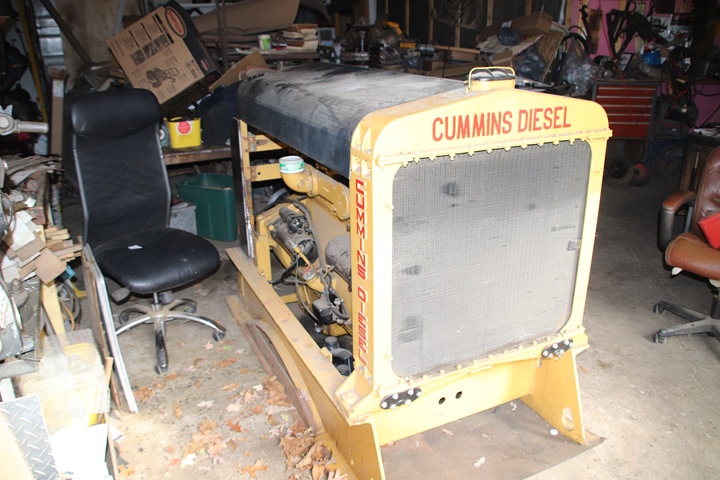
This 1945 Cummins HB150 has a Twin Disc Model SP211-HPP clutch.
Author's Photo.
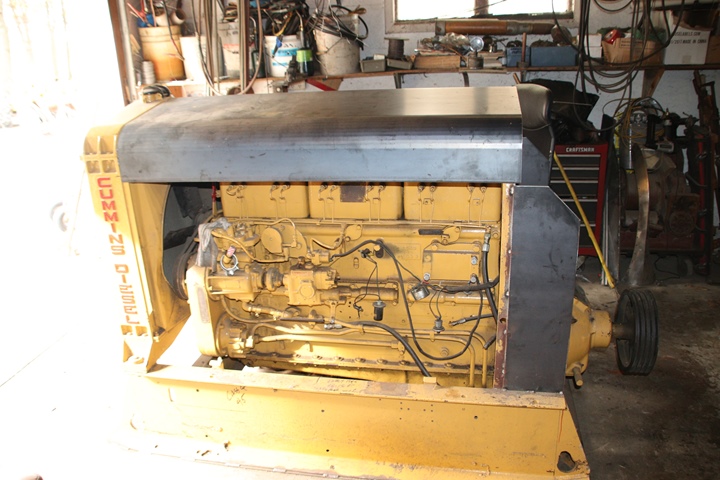
Author's Photo.
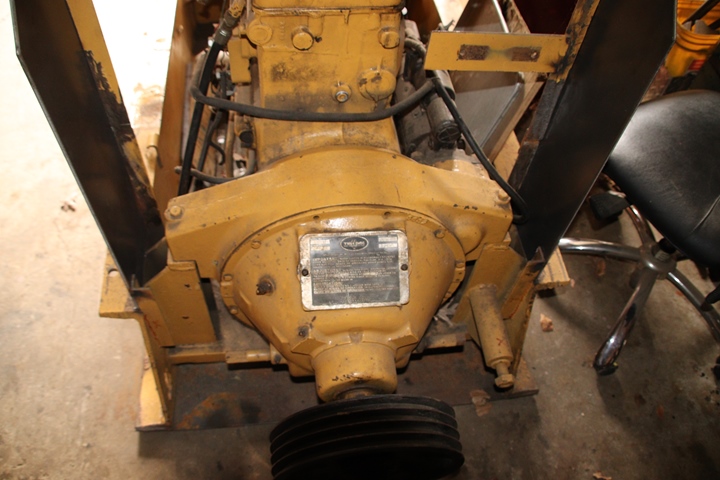
Author's Photo.
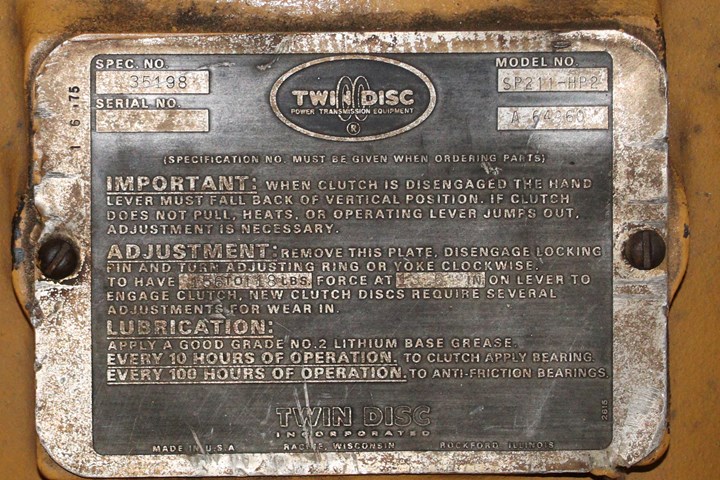
Author's Photo.
The Twin Disc World War Two Factory:
The factory in Racine was located on what is now 32nd Division
Memorial Highway, previously Racine Street, between 13th and 14th
Streets.
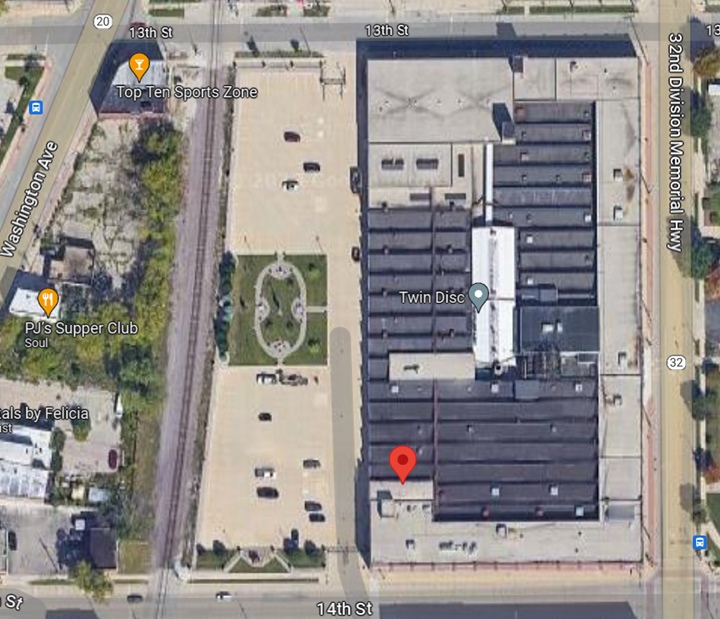
Image courtesy of Google Maps.
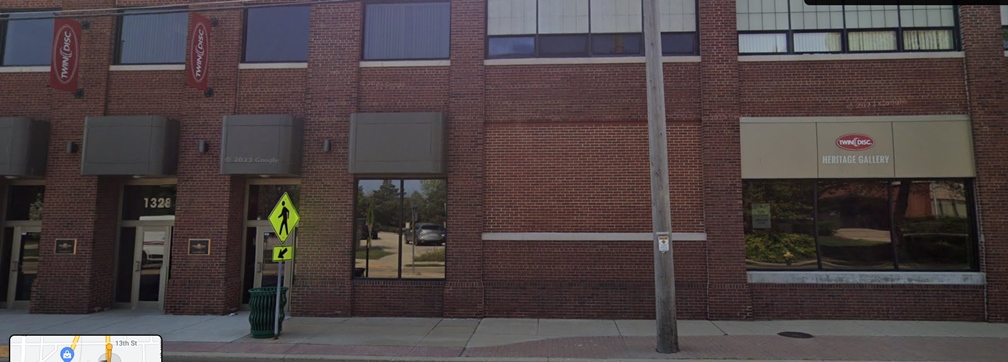
The company's address was 1328 Racine Street in Racine, WI. Twin
Disc moved out of this facility in 2022. The Heritage Center that
was located in this building may no longer exist. The transmission
that is at the National World War II Museum in New Orleans, LA appears
to have previously been on display at the Heritage Center. Image
courtesy of Google Maps.
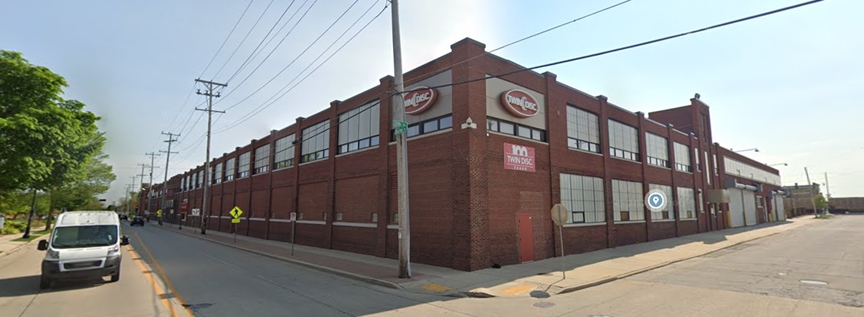
This is the northeast corner of the building at the intersection of
Racine Street and 13th Street. Image courtesy of Google Maps.

This is the west side of the plant. The
original plant was yellow brick. The red brick sections are later additions
to the structure. This view is from 13th Street. Image
courtesy of Google Maps.

This view is from 14th Street.
Image courtesy of Google Maps.
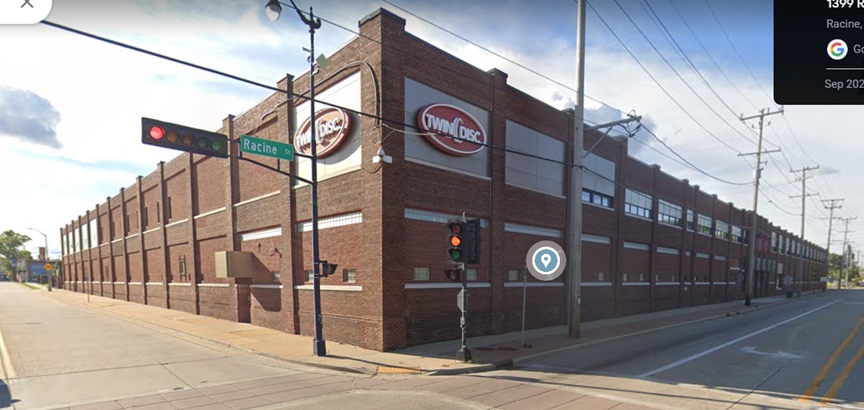
This image shows the plant at Racine and 14th
Streets. Image courtesy of Google Maps.
|


























































